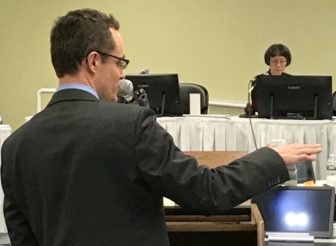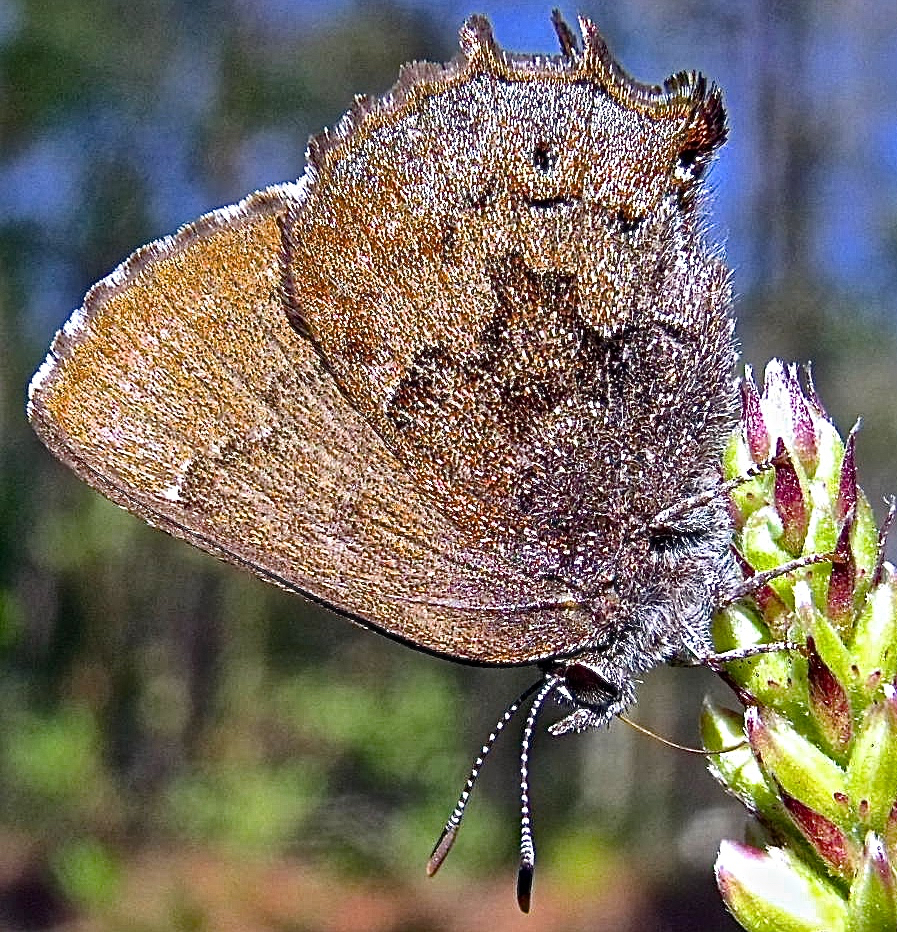Please sign up for InDepthNH.org’s free weekly newsletter published every Friday
By GARRY RAYNO, InDepthNH.org
CONCORD — Recent revisions improved measures to protect the eco-system along the 192-mile route of the Northern Pass Transmission project, experts said Tuesday, but opportunities to better guard endangered species and wildlife have been missed.
Counsel for the Public hired the expert environmental panel to review proposed “avoidance and minimization measures” to protect the ecology along the route from Pittsburg to Deerfield for the $1.6 billion project to bring 1,090 megawatts of Hydro-Quebec electricity to the New England electric grid.
Under Site Selection Committee rules, developers are required to use best practices to avoid or minimize impacts to natural and historical resources from the project.

Garry Rayno photo
Counsel for the Public Christopher Aslin questions intervenor Mary Lee of Northfield during adjudicative hearings before the Site Evaluation Committee Tuesday on the Northern Pass Transmission project.
Several members of the panel noted that no survey was done of several rare species of butterflies in the Concord Pine Barrens. Instead, the developer focused on the Karner Blue Butterfly.
The species are considered endangered by the state, but not the federal government so no federal money is available to track the species, said Karner Blue expert Michael Amaral.
He said the scope of his work focused on the Karner Blue and wild lupine while “the coattails picked up the ecological requirements of other species.
“There are no readily available experts and because they are not federally endangered, there is not a lot of federal money available,” Amaral said. “It’s a missed opportunity where more information could have been collected.”
Site Evaluation Committee member Christopher Way, representing the Department of Business and Economic Affairs, asked if there should be avoidance and minimization measures for the endangered species beyond the Karner Blue Butterfly.
Jeff Parsons, senior wildlife biologist and wetland ecologist at Arrowwood Environmental, LLC of Huntington, Vt., said work was never done to identify these species.
“It’s a roll of the dice for the Frosted elfin,” Parsons said. “We have no idea which patch or sub patch of wild lupine the Frosted elfin chooses. We just don’t know and how that differs from the Karner Blue.”
Attorney Jeremy Walker, representing Eversource, noted the U.S. Fish and Wildlife Service found the project would not jeopardize the continued existence of the Karner Blue and the impact would be temporary.
He asked Amaral if he agreed with the federal agency.
Amaral said the federal agency uses a jeopardy standard as something that would cause extinction. The Karner Blue ranges from New Hampshire to Wisconsin so what happens in Concord will not cause extinction of the species, he noted.
Amaral did say recent changes to move two towers away from a significant patch of wild lupine greatly reduced the impact on the plant and butterfly species.
Asked about a 7-acre parcel in Pembroke to be used to mitigate the impact on the wild lupine, Amaral said the plant grew on that parcel before the topsoil was removed and would grow again if property restored.
But he said the state Fish and Game Department does not have the money to restore the parcel and the plant, and suggested a condition for the project should be funding for that work.
Walker asked the panel if they were satisfied if the avoidance and minimization measures were followed there would not be unreasonable adverse impacts on species, and Michael Lew-Smith, project director and senior botanist and ecologist with Arrowwood, said he still believes some species would be unreasonably impacted.
Bat expert Scott Reynolds noted the original measures did not address the small-footed bat likely found in many areas of the proposed transmission line.
But he noted neither the Fish and Game Department nor the Natural Heritage Bureau have any staffers who are knowledgeable about bats.
He said each revision to the proposed protective measures for bats are more vague “so we don’t know what the limitations are.”
He said generally if the measures are followed there is likely no adverse impact to the bats they studied, but they did not address the small-footed bat.
Reynolds noted the small-footed bat is like the endangered butterflies, they have not been granted federal protection so “we know nothing about them.”
The protections for the northern long-eared bats will help the small-footed bats, he noted, but “you’ve got to look for them and they really didn’t. We just don’t know enough.”
Committee members questioned the panel about environmental monitors and how they would be used to ensure the protective measures are followed.
Way said the committee was concerned how “you take this from the desktop to the field. How does this work in the field? Do you have the authority to stop construction in the real world?”
Lew-Smith said organizationally making monitoring function is difficult.
It is very important to have the authority to stop work, he said. Who do you answer to and who oversees the process is very complicated, Lew-Smith said. “Ultimately you should be answerable to someone other than the applicant.”
Eversource had hoped to have all federal and state permits by the end of this year with construction to begin next year and the transmission line finished by the end of 2020.
The Site Evaluation Committee is not expected to make a final decision on the high-voltage transition line until the end of February.
If all permits are received, project officials said earlier, construction could begin in April.
The adjudicative hearings continue Wednesday.
Garry Rayno can be reached at garry.rayno@yahoo.com





